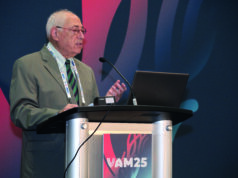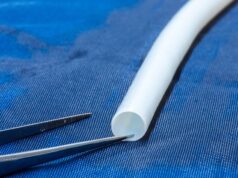Dr. Michael Ellis DeBakey, pioneer heart surgeon and medical device innovator, died July 11, 2008, in Houston, about 2 months shy of his 100th birthday on Sept. 7.
In his lifetime, Dr. DeBakey was renowned for his immense contributions to the progress of medical science, such that he was declared a “living legend” by the Library of Congress and was this year awarded a Congressional Gold Medal for his lifetime achievements, in particular his pioneering work as a heart surgeon.
And although it was as a heart surgeon that Dr. DeBakey gained greatest fame, his accomplisments in vascular surgery were unique and profound, from his development of the Dacron graft to his active membership in the SVS, and his role as founder and first editor of the Journal of Vascular Surgery.
Even before Dr. DeBakey received his medical degree from Tulane University in 1932, he began his contributions to modern medicine by developing a small continuous flow–roller pump designed to improve blood transfusion—a device that would later be used by Dr. John Gibbon as a crucial component of his heart-lung machine. And in 1939, with his mentor, Dr. Alton Ochsner, Dr. DeBakey suggested a strong link between smoking and lung cancer.
After internships in New Orleans and surgical training in Europe, Dr. DeBakey volunteered for service during World War II and was assigned to the U.S. Army Surgeon General’s office. From his observations in the field, he became convinced of the need for a mobile surgical unit that would give soldiers access to high-level medical treatment on the combat field and convinced the surgeon general to form what would become the mobile army surgical hospitals (MASH units)—an innovation that gained him the U.S. Army Legion of Merit in 1945.
His government service continued throughout his civilian career, as he helped to establish the Veterans Administration medical center research system. He also initiated the movement that in 1956 took the Army’s poorly housed medical library and used it to create the National Library of Medicine, of which he was first board member and then chairman. He served three terms on the National Heart, Lung, and Blood Advisory Council as well. He was responsible for helping establish health care systems in a host of countries, including Belgium, China, Egypt, England, Germany, Saudi Arabia, Australia, and numerous other Middle Eastern and Central and South American nations.
According to the Web site of Baylor College of Medicine’s department of surgery, where he spent almost his entire postwar career, Dr. DeBakey operated on more than 60,000 patients in the Houston area alone. But these were not all just standard operations. In 1953, he performed the first successful carotid endarterectomy, as well as the first successful removal and graft replacement of a fusiform thoracic aortic aneurysm, and in 1954, the first successful resection and graft replacement of an aneurysm of the distal aortic arch and upper descending thoracic aorta.
In 1955 he performed the first successful resection of a thoracoabdominal aortic aneurysm using the DeBakey Dacron graft—the first artificial arterial graft of its kind.
“If we now tried to develop the Dacron graft the way we developed it, I am not sure we would have it today with the way they regulate things. …When I went down to the department store . . . they said, ‘We are fresh out of nylon, but we do have a new material called Dacron.’ I felt it, and it looked good to me. So I bought a yard of it. . . . I took this yard of Dacron cloth, I cut two sheets the width I wanted, sewed the edges on each side, and made a tube out of it. . . . We put the graft on a stent, wrapped nylon thread around it, pushed it together, and baked it. . . . After about two or three years of laboratory work on my own [including experiments in dogs], I decided that it was time to put the graft in a human being. I did not have a committee to approve it. . . . In 1954, I put the first one in during an abdominal aortic aneurysm. That first patient lived, I think, for 13 years and never had any trouble,” Dr. DeBakey related in an interview published in 1996 in the Journal of Vascular Surgery.
And among his other pioneering surgical developments, in 1964, Dr. DeBakey was the first to perform a successful coronary artery bypass, using a portion of leg vein as the graft, in what is now one of the most commonly performed heart operations—coronary artery bypass grafting.
As if surgically repairing failing hearts was not enough, Dr. DeBakey became a pioneer of artificial heart research and of cardiac assist devices. On July 18, 1963, after years of animal research, he performed the first successful human implantation of a left ventricular assist device (LVAD), one which he devised; the patient died after 4 days from causes unrelated to the technology. In 1966, Dr. DeBakey’s redesigned, extracorporeal pneumatic pump was used in a 37-year-old woman who could not be weaned from the heart-lung machine after dual valve replacement. After 10 days of LVAD support, she recovered sufficiently for the pump to be removed and she survived. This pump served as the basis of Dr. DeBakey’s first total artificial heart model, created in 1968.
Dr. DeBakey was honored profusely throughout his lifetime by the medical community and the general public. Numerous medical facilities are named after him in this country and around the world. He received countless awards for his technical and social achievements in medicine. Among these honors were the American Medical Association’s Distinguished Service Award (1959), the Albert Lasker Award for Clinical Medical Research (1963), the Presidential Medal of Freedom (1969), and the National Medal of Science (1987). More recently, he was the first foreign member elected to the Russian Academy of Sciences (1999), was given the Library of Congress Bicentennial Living Legend Award (2000), and was awarded the Congressional Gold Medal in April 2008.
In his death, Dr. DeBakey was the first Houston resident given the honor of lying in state at City Hall and, at the request of his family, he lay dressed in his characteristic glasses, scrubs, and white coat for viewing by long lines of the general public.n
Sources and suggested readingsHeart Fail. Clin. 2007;3:117-20.J. Vasc. Surg. 1996;23:1031-4.











